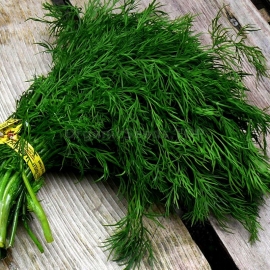
«Shmaragd» - Organic Dill Seeds
1.14 €
40 days from transplanting seedlings. Among the most useful of herbs, dill is fragrant, attractive, and delicious. A member of the same family as parsley and cumin, its seeds have a flavor reminiscent of caraway while its leaves have a gentler.
-
Ukrainian Heirloom Dill «Shmaragd»
40 days from transplanting seedlings. Among the most useful of herbs, dill is fragrant, attractive, and delicious. A member of the same family as parsley and cumin, its seeds have a flavor reminiscent of caraway while its leaves have a gentler, more subtle taste. It belongs front and center in your sunny herb garden!
Dill is an annual with feathery blue-green leaves and tiny yellow blooms that produce masses of small brown seeds in fall. Both leaves and seeds are used in cooking, lending their flavors to everything from pickles to potatoes, eggs to fish.
For a regular supply of dill leaves, make successive sowings of the seed every 2 to 3 weeks in well-drained, neutral to slightly acid soil in full sun. Dill prefers to be direct-sown, and should not be covered with too much (if any) soil at planting time. Do not plant near carrots, as they react adversely, or too close to fennel, because the flavor can be affected. However, cabbage seems to like dill nearby, and it's a nice companion to onions.
Even if it were not so delicious, dill would be a valuable addition to the garden, both for its attractive umbrella-like flowers and its ability to attract beneficial insects that prey on aphids and other destructive pests int he garden.
How to Grow
In addition to providing aromatic seeds and foliage, dill will brighten your garden with its yellow-green flowers in spring and fall. While typical dill grows to a height of 2 to 4 feet, Fernleaf dill is more compact, growing only 18 to 24 inches tall. It is a warm-season annual, but really loves mild weather–not too hot, not too cold. With its slender stem and delicate leaves, it makes a good mid- to back-of-the-border addition to your garden. Try growing dill in a spot where it can easily reseed.
Dill likes direct sun and rich, well-drained soil with a pH between 5.5 and 6.5. Use organic matter to enrich the soil before planting. This plant likes mild weather and is best in the spring and again in fall. You may set out plants following the last spring frost and then plant again two months prior to the first winter frost. Space them 12 to 15 inches apart. Be sure to keep plants watered in dry weather.
Plants may need staking when in bloom to keep the tall flower stems-true butterfly magnets-from falling over, especially if you get a lot of wind. You can keep plants cut to delay flowering and extend your harvest, or harvest the whole plant as soon it flowers. The first winter frost will kill dill planted in the fall. However, if it had time to go to seed, the fallen seed may produce new plants in the spring.
